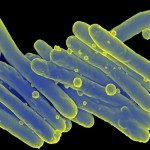Link to Pubmed [PMID] – 28545104
Link to DOI – 10.1371/journal.ppat.1006399
PLoS Pathog 2017 May; 13(5): e1006399
Sensing and response to changes in nutrient availability are essential for the lifestyle of environmental and pathogenic bacteria. Serine/threonine protein kinase G (PknG) is required for virulence of the human pathogen Mycobacterium tuberculosis, and its putative substrate GarA regulates the tricarboxylic acid cycle in M. tuberculosis and other Actinobacteria by protein-protein binding. We sought to understand the stimuli that lead to phosphorylation of GarA, and the roles of this regulatory system in pathogenic and non-pathogenic bacteria. We discovered that M. tuberculosis lacking garA was severely attenuated in mice and macrophages and furthermore that GarA lacking phosphorylation sites failed to restore the growth of garA deficient M. tuberculosis in macrophages. Additionally we examined the impact of genetic disruption of pknG or garA upon protein phosphorylation, nutrient utilization and the intracellular metabolome. We found that phosphorylation of GarA requires PknG and depends on nutrient availability, with glutamate and aspartate being the main stimuli. Disruption of pknG or garA caused opposing effects on metabolism: a defect in glutamate catabolism or depletion of intracellular glutamate, respectively. Strikingly, disruption of the phosphorylation sites of GarA was sufficient to recapitulate defects caused by pknG deletion. The results suggest that GarA is a cellular target of PknG and the metabolomics data demonstrate that the function of this signaling system is in metabolic regulation. This function in amino acid homeostasis is conserved amongst the Actinobacteria and provides an example of the close relationship between metabolism and virulence.








